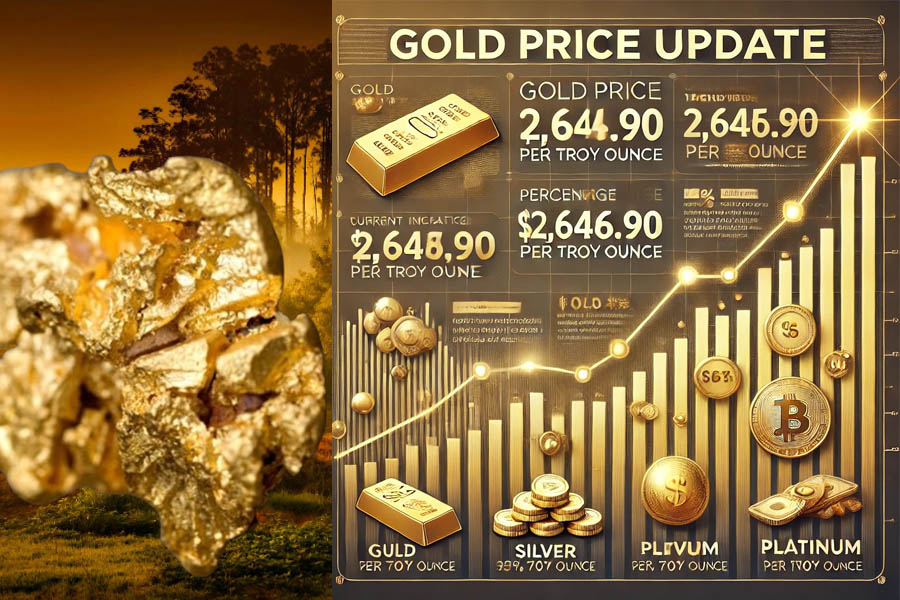
Gold Price Increase Today: A Comprehensive Analysis of the Surge and Market Dynamics
9-Oct-2024Gold has always been a beacon of stability and wealth, especially in times of economic uncertainty. On October 9, 2024, the price of gold experienced a notable uptick, reflecting both ongoing global dynamics and investor sentiment. This article delves into the current state of the gold market, explores the factors driving today's price increase, compares it with other precious metals, and offers insights into investment strategies. Additionally, a Q&A section at the end addresses common queries about gold investment.
---Current Gold Price Snapshot
As of 9 a.m. ET on October 9, 2024, gold is trading at $2,646.90 per troy ounce, marking a 0.26% increase from yesterday's closing price. Remarkably, this surge places gold 28.10% higher since the beginning of the year. Within the last 24 hours, gold prices fluctuated between a low of $2,628.61 and a high of $2,653.73 per ounce.
Understanding the Metrics: XAU/USD and Spot Prices
- XAU/USD: This is the most common label for tracking the spot gold price in U.S. dollars. Here, XAU represents one troy ounce of gold, and USD signifies the U.S. dollar. The price indicates how much one ounce of gold costs in USD. Other forex pairs like XAU/EUR (euros) and XAU/GBP (British pounds) are also used in international markets.
- Spot Gold Price: This refers to the current price at which gold can be bought or sold for immediate delivery. While typically quoted per troy ounce in USD, spot prices can also be expressed per gram or kilogram. Notably, a troy ounce is slightly heavier than the standard ounce used in everyday measurements.
Gold Price Chart Analysis
The gold price chart over the past year illustrates significant volatility and growth. Updated at 9 a.m. ET, the chart does not include intraday lows or highs. Year-to-date, gold has appreciated by 28.10%, with the 52-week high reaching $2,685.61 on September 26, 2024, and the 52-week low dipping to $1,832.63 on October 9, 2023. This substantial growth underscores gold's resilience and its role as a preferred investment during turbulent times.
---Factors Driving Today's Gold Price Increase
Several interrelated factors have contributed to the recent rise in gold prices:
- Geopolitical Tensions: Ongoing conflicts and instability in regions like the Middle East have heightened demand for gold as a safe-haven asset. Investors flock to gold to safeguard their wealth against uncertainties.
- Federal Reserve's Monetary Policy: The Federal Reserve's stance on interest rates plays a pivotal role in gold pricing. While high interest rates typically bolster the U.S. dollar and suppress gold prices, the anticipation of potential rate cuts has rekindled investor interest in gold.
- Inflation Hedge: Persisting global inflationary pressures make gold an attractive hedge. Investors seek to preserve the purchasing power of their assets by allocating funds to gold.
- Central Bank Purchases: Increased gold acquisitions by central banks, particularly in emerging economies, add upward pressure on prices. These purchases signal confidence in gold's long-term value.
- Strength of the US Dollar: Although a strong dollar generally inversely affects gold prices, current dynamics suggest that gold remains resilient, maintaining its value around the $2,600 mark despite dollar strength.
Investment Insights: Should You Take Profits?
With gold prices nearing their peak levels for the year, some strategists advise investors to consider taking profits. Here’s why:
- Profit-Taking Advantage: Selling a portion of gold holdings now could lock in gains before any potential market correction, especially given the strong performance this year.
- Market Volatility Ahead: Upcoming events like the Federal Open Market Committee (FOMC) minutes could introduce short-term volatility, making it prudent to secure profits amidst the current rally.
However, for long-term investors, gold still presents a compelling case due to ongoing inflation risks and geopolitical uncertainties. Balancing between taking short-term profits and maintaining long-term positions can be a strategic approach.
---Gold Investment Options: Navigating the Choices
Investors have multiple avenues to invest in gold, each with its own set of advantages and considerations:
- Physical Gold: Includes bars, coins, and jewelry. While tangible, it incurs storage and insurance costs. Additionally, the spread between buying and selling prices can impact returns.
- Gold Exchange-Traded Funds (ETFs) and Trusts: Offer liquidity and ease of management without the hassles of physical storage. However, they come with management fees and may not always perfectly track spot prices.
- Gold Mining Stocks: Investing in companies that mine gold can offer leveraged exposure to gold prices. These stocks are influenced by both the company's performance and gold price movements.
- Gold Futures: Contracts to buy or sell gold at a future date. Futures can provide significant leverage but come with higher risk and complexity.
Each investment vehicle carries its own risk-reward profile, making it essential for investors to align their choices with their financial goals and risk tolerance.
---Comparative Analysis: Other Precious Metals
While gold often steals the spotlight, other precious metals like silver, platinum, and palladium also play significant roles in the commodities market. Here's a brief overview of their current status:
Silver
Current Price: $31.20 per ounce (down 0.92% from yesterday)
Year-to-Date Change: Up 30.40%
24-Hour Range: $31.00 - $31.92 per ounce
Insights: Silver serves both as a store of value and an industrial metal. Its diverse applications in electronics, healthcare, and automotive sectors make its market dynamics unique. The substantial YTD increase highlights robust demand and investor interest.
Platinum
Current Price: $965.20 per ounce (down 1.40% from yesterday)
Year-to-Date Change: Down 2.28%
24-Hour Range: $962.20 - $985.43 per ounce
Insights: Platinum's primary use in automotive catalytic converters ties its demand to the automotive industry's health and emission standards. The push towards cleaner cars can influence its demand, making platinum prices sensitive to regulatory changes.
Palladium
Current Price: $1,019.91 per ounce (up 1.18% from yesterday)
Year-to-Date Change: Down 7.24%
24-Hour Range: $995.96 - $1,031.64 per ounce
Insights: Palladium, like platinum, is essential in catalytic converters. Its scarcity and the trend toward stricter emission standards support its demand, leading to significant price fluctuations.
---Is Gold Dropping in Value?
Contrary to the question, gold has not been dropping in value when viewed year-to-date. From the start of the year until October 8, 2024, gold's price surged from $2,066.32 to $2,646.90 per troy ounce, marking a 28.10% increase. This robust performance underscores gold's role as a reliable investment during times of economic and geopolitical turbulence.
---Is It a Good Time to Buy Gold?
Deciding whether to invest in gold depends on individual financial goals, investment timelines, and market outlooks. Here are some considerations:
- Pros:
- Hedge Against Inflation: Gold preserves purchasing power during inflationary periods.
- Safe-Haven Asset: In times of geopolitical instability, gold retains its value.
- Diversification: Adding gold to a portfolio can reduce overall risk.
- Cons:
- Market Volatility: Short-term fluctuations can impact returns.
- Opportunity Costs: Funds allocated to gold could yield higher returns in equities or other assets.
Ultimately, conducting thorough research and consulting financial advisors can help investors make informed decisions.
---Conclusion: Navigating the Gold Market
The surge in gold prices today reflects complex global dynamics and investor sentiment. Understanding the factors at play, evaluating other precious metals, and carefully considering investment options are crucial steps for investors in navigating this market. Whether it’s through physical gold, ETFs, or mining stocks, each choice carries its risks and rewards. Stay informed, and consider your financial goals as you explore the world of gold investment.
---Frequently Asked Questions
1. Why is gold considered a safe-haven asset?
Gold is viewed as a safe-haven asset due to its historical stability and ability to retain value during economic downturns and geopolitical instability.
2. How do I start investing in gold?
Investing in gold can be done through physical gold, ETFs, mining stocks, or futures. Researching each option's benefits and risks is crucial.
3. What factors influence gold prices?
Gold prices are influenced by geopolitical tensions, central bank policies, inflation rates, and overall demand from investors and industries.
4. Is it better to buy gold now or wait?
Timing the market can be challenging. It's essential to evaluate your financial situation, market trends, and consult with financial advisors to make informed decisions.
Tags: #GoldPriceUpdate 💰 #InvestInGold 📈 #PreciousMetals 🏅 #GoldTrading 💹 #SilverPrices 🔗 #PlatinumValue ⚪ #PalladiumMarket 🔄 #GoldInvestment 💎 #MarketTrends 📊 #FinancialNews 🌐 #GlobalPostHeadline
Thank you for reading: Globalpostheadline.com





